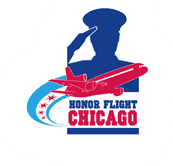Army Vietnam War Frankfort, IL Flight date: 04/09/25
By Al Konieczka, Honor Flight Chicago Veteran Interview Volunteer
Ron Miller was born and raised in East Chicago, IN. While in the third grade, tragedy struck the family when their house caught fire and burned to the ground. Ron’s mother was a single mom with three young children. After the fire, the family was transferred to live in a federal housing project in Hammond, IN.
Ron completed high school and then went through chef training at Washburn Trade School along with a friend. After completing an Associate’s Degree, he began working at the rotating restaurant on Michigan Avenue in Chicago and thought his life was finally moving forward in a positive direction. That newfound success came to a halt though when he received his draft notice from the Army at the age of 22.
Ron spent three months in basic training, from May through July of 1967 at Fort Leonard Wood. Ron jokingly referred to his time in basic as Fort Lost in the Woods. Ron was in basic training for just a few weeks when he had to travel home for a brief emergency leave of absence. Ron received word that his father, who served in World War II, had passed away at The Downey VA Hospital. At the time, Downey was a Neuropsychiatric (or NP) facility and the country’s largest VA Hospital with 1800 beds. It was located about 35 miles north of Chicago adjacent to The Great Lakes Naval Training Center.
Ron admitted that he wasn’t very fit when he began his basic training but certainly was in great shape and much lighter by the time he completed basic. At the end of basic training Ron was classified as light weapons infantry. He went on to Advanced Individual Training (AIT) at Fort Polk, Louisiana. In the Army, AIT is the phase where soldiers, after completing Basic Combat Training (BCT), receive specialized training in their specific Military Occupational Specialty (MOS).
Ron recalled the time he spent at Fort Polk. “God needed somewhere to put all the snakes and the bugs and he called it Fort Polk. I was definitely not a fan of all the creatures I encountered during my time at Fort Polk. We ran five mile runs each day and came across all types of critters.” Ron was at Fort Polk from July to September of 1967. By the time Ron left Fort Polk, he was fully qualified on the M14, M16, M60 and also the M79, which was a grenade launcher. The first of its kind in U.S. military service, the M60 General Purpose Machine Gun replaced at least three other guns. Nicknamed “The Pig,” the M60 saw service on the ground, on the water and in the air. At one point, Ron wrote his girlfriend Elizabeth back home and told her he had a ‘girlfriend’ in Vietnam. When she wrote back, Elizabeth asked to see a picture of his girlfriend and Ron sent home a photo of him kissing his M60 Machine Gun.
After Fort Polk, Ron returned home to attend his sister’s wedding and then went on to Fort Knox in Kentucky. For 60 years, Fort Knox was the home of the U.S. Army Armor Center and School, and was used by both the Army and the Marine Corps to train crews on the American tanks of the day. At Fort Knox, Ron spent three weeks training to drive an Armored Personnel Carrier (or APC) before leaving for Vietnam in October of 1967. The M113 Armored Personnel Carrier (APC) was a heavily used and versatile armored vehicle during the Vietnam War, known for its mobility, firepower, and troop protection, and was instrumental in conducting various missions.
Ron flew to Vietnam on a commercial airline from California to Anchorage, Alaska and on to the Yokota Air Base in Japan before finally arriving in Saigon, Vietnam on October 27, 1967. Ron described his first thoughts as he stepped off the plane in Vietnam. “It was a totally different atmosphere when I stepped off that plane in Vietnam. First of all it was very hot and humid. In addition, there were huge piles of sandbags on each side of the plane – it was like being in a tunnel without a roof.”
Once in Vietnam, Ron went to a holding center and was eventually assigned to Charlie Company, 5th Battalion of the 60th Infantry Brigade. Ron’s company was stationed at a base in Binh Phuoc. Ron described the conditions at base camp. “The base camp had a few buildings – an armory, a headquarters, and a PX but most all other structures were tents. The soldiers slept in tents, with about 10 soldiers per tent. We were in a really remote area. We had daily patrols. There were three GIs and three ARVNs (Army of the Republic of Vietnam) and we would patrol the base. The ARVNs were cowards. One time on patrol we came across a few VC soldiers and the ARVNs ran off and left us.“
There was a long road that connected the nearby town to the base camp. Ron and his team of engineers had to clear that road each morning by sweeping for mines. In addition, Ron was assigned to guard the camp berm every other day. When Ron wasn’t driving his APC (nicknamed 007), he would also participate in various missions travelling by helicopter to locations where ground troops needed assistance from additional infantry soldiers.
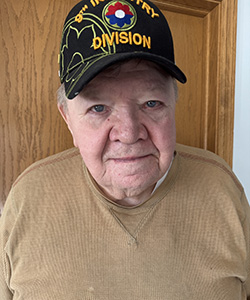
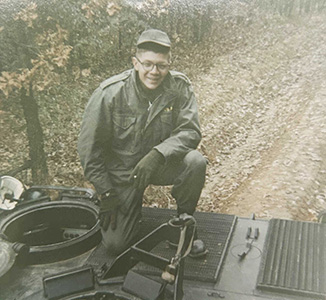
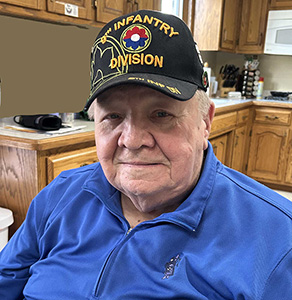
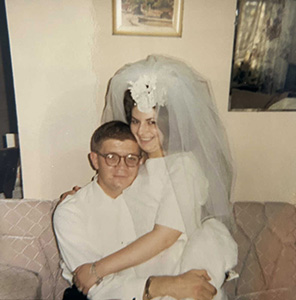
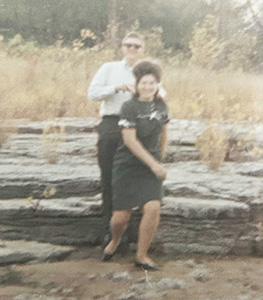
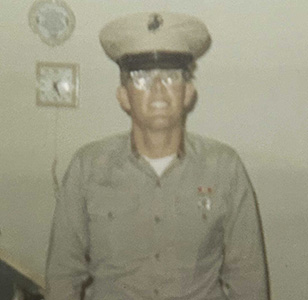
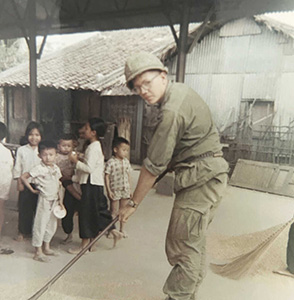
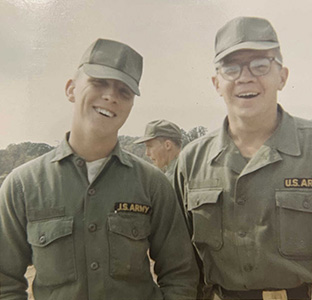
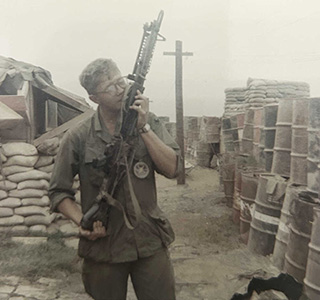

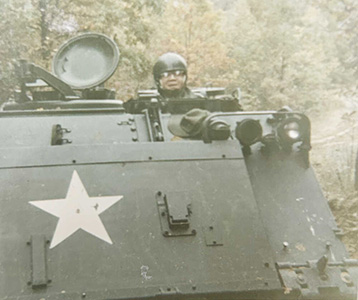
Ron recalled one memorable helicopter ride while in Vietnam, “One time on a helicopter mission we arrived at a hot LZ and I was in the middle seat on the chopper. Those pilots didn’t like to stay there for very long. I was the last one off the chopper and by the time I jumped, the chopper was 10-12 feet or so off the ground and I went straight into the mud like a spear. It took like three guys to pull me out of there.“
While Ron was only in country for about 3 months, he received two Purple Hearts. The first time Ron was injured he was at Fire Base Cudgel in November, 1967. Ron described the scene. “I was operating as headquarter security next to the command post during a fire fight as the Viet Cong were trying to overrun the base. Somehow two enemy soldiers got into the camp and surprised me. Just as the VC soldier was about to stab me with his bayonet, I grabbed the bayonet and as we struggled, I shot and killed him with my 45. A second later another VC soldier jumped up and I shot and killed him also. To this day I have no idea how they got inside the fire base camp.” He was put in for a Purple Heart and it was shipped home. His mother threw it away because she said she didn’t want a medal, she just wanted her son home.
Ron’s primary role in Vietnam was to drive an APC sweeping for mines. Ron explained the procedure. “There were rice paddies all around the camp. The engineers would drop a mine sweeping rig behind the APC, and we would drag it through the rice paddies looking for mines.”
Ron described events that led to his second purple heart, an injury that would ultimately send him home from Vietnam in January 1968. “We had completed our mine sweep and came up out of the rice paddy and were returning to base camp when we hit a mine. There was a woman on the side of the road, and I think the VC were using her as an aiming stake. I was blowing the horn for her to get off the road but she wouldn’t move. When we entered that area, the Viet Cong set the mine off.”
Ron was blow off his seat inside the APC and hit his head and would later find out he had also fractured his back. Ron looked up at the driver’s hatch and saw the Browning .50 caliber machine gun. There was fire coming from the tree line. Ron told me, “I began returning fire using the .50 caliber machine gun. A round of enemy fire must have ricocheted off the open hatch door and it hit me in the face. It took out most of my teeth and most of my good looks.” Ron would be laid up for 9 months from that injury.
Ron was airlifted to a hospital at Bien Hoa. While being treated, that location was hit hard by the enemy and Ron was quickly moved to a hospital at Cam Ranh Bay where he stayed for 5-6 days until being transferred to the Air Force base in Yakoda, Japan. He was treated in a makeshift hospital ward in what used to be the library. Ron was treated along with another Army soldier and nine Marines.
Ron joked, “The Marines would always get on us about how much better they were than the Army. But I noticed that they had all been injured in the back. When they gave me a hard time, I would tell them, there’s only one way you get injured in the back. The fighting is this way and you’re heading away from it.“
When Ron finally returned stateside, as he walked through the airport terminal, he saw his girlfriend Elizabeth walking towards him and she walked right past him. She didn’t event recognize him due to his injury. Ron ended up at Fitzsimons Army Hospital in Aurora, Colorado, where he spent eight months receiving treatment and surgeries for his facial and dental injuries sustained in the APC accident.
At the end of his treatment Ron took a job at the hospital in the oral surgery unit autoclaving dental instruments. Autoclaving, or steam sterilization, is a crucial process in dentistry for eliminating microorganisms from dental instruments, preventing the spread of infections, and ensuring patient safety. This process uses high-pressure steam to kill bacteria, viruses, and fungi.
Ron returned home in March of 1968 and got married to Elizabeth on March 16. Ron needed a suit for his wedding so he went to Chicago in his uniform since it was the only thing that fit him. Ron laughed as he told me, “Downtown Chicago I was confronted by two Hare Krishna members who were in my face and verbally harassing me about being in the war and with one punch I just took him out. People all around me were clapping and I thought, I’m getting married in a few days, I can’t do that from a jail cell so I ran off.“
After getting married, they were expecting to return to Colorado when Ron got orders to report to Fort Hood in Texas. By this time he discovered his new wife was also pregnant. Ron recalled, “I spoke to my Colonel and he spoke to the commander of the dental clinic at Fitzsimons and I got my MOS changed from light weapons infantry to dental assistant and I was able to return to Fitzsimons Army Hospital and serve out the remainder of my tour at that facility until I was discharged in May of 1969.“
Ron told me his experiences in Vietnam have caused him issues with his sleep, his temper and other issues associated with his PTSD. Ron’s wife Elizabeth sat at the kitchen table with us as I interviewed Ron. She nodded in agreement as Ron talked about his PTSD. Elizabeth added, “We went on our honeymoon right after we got married. We went down to Florida. I remember the first night I went over to wake him up and he jumped up at me and I thought – whooaa. He told me don’t ever do that again. Even to this day when we go to a restaurant, he has his back to the wall and his face pointed towards the door so he can see what’s coming towards him.” While Ron’s PTSD stayed in check as they had children and Ron worked, when he retired in 2008 his PTSD returned in full force. Ron told me that he now plays video games to keep his mind busy and help him combat his PTSD.
When Ron and his new wife Elizabeth returned to the Chicago area from Colorado, Ron expected to get back into the culinary field, but he couldn’t stand for long periods of time. He saw an ad looking for new recruits as financial advisors. Ron answered that ad and ended up working for the same company as a financial advisor from 1976 until he retired in 2008. He and his wife also owned a few Subway restaurants in the past as the company was first starting out.
Ron and Elizabeth have three children – a son and two daughters. Their son served during Desert Storm. They have eight grandchildren. The first seven grandchildren were girls before a grandson finally arrived. Now in retirement Ron belongs to a group called the Builders Tee. The club plays golf during the warm weather months and then bowl and play tennis.
Ron, thank you very much for your dedicated service and please enjoy your well-deserved trip to Washington D.C.!

